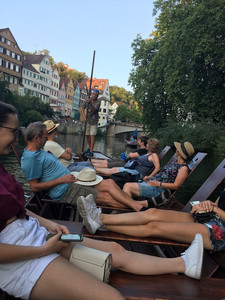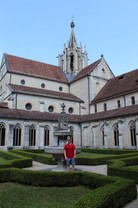Tübingen + Kloster Bebenhausen
- Alex Place

- Nov 13, 2020
- 2 min read
Tübingen is a university town in Southwestern Germany. I love visiting university towns because they remind me that I am not a 70 year old farmer. Where I live now is lovely, but the slower pace of life leaves me feeling stagnant and restless. Especially after being locked down all summer, Tübingen was invigorating and just what I needed.
One of the most advertised attractions in Tübingen can be found at the University's Museum of Ancient Cultures. There is a UNESCO World Heritage Site exhibit showcasing the oldest evidence of figurine art ever discovered. These pieces were carved out of mammoth ivory and bone during the last Ice Age, around 40,000 years ago! The posters all over town make them look huge, but in reality they were only a several inches long.
On a summer evening, most of the town could be found along the Neckar River. Restrictions weren't as tight then, and friends could gather and enjoy the nice weather with a cold brewski. We took a punting trip down the river, and saw friends catching up with their feet in the water, having barbecues on the river's narrow island, and clumsily steering their own boats complete with coolers and charcuterie boards, which we eyed jealously from where we sat. Jealous because we were hungry, but also because we miss our friends.
I was on the lookout for some type as we walked around. There were a few places here and there, but really nothing outrageous until we came upon the Eppelhaus. It is a self-managed youth center in Tübingen named after 17-year-old Richard Epple, who was shot and killed by police in a 1972 car chase. The messages translated are "Rassimus kills every day, everywhere & also lives in us!" and "No human is illegal".
About twenty minutes up the road is the Medieval Bebenhausen Monastery and Palace. The whole complex was beautiful, and we took a tour in German (with an English brochure). They kept us all spaced out, putting little circles on the floor of each room 6 feet apart where we had to stand. Some of the buildings were converted into a royal hunting palace during the 19th century. I found it interesting that after the monarchy was dissolved in 1918, the royal couple Wilhelm II and Charlotte were allowed to live out the rest of their lives there. My favorite part was, of course, the statues in the church.
On our last morning in town, we walked to the main square and sat outside with our chocolate croissants and caffè cremas. We heard some cheering and saw a newly married couple standing on the balcony of the courthouse, waving to their family down below as an accordion played a cheerful tune. Everyone else in the square joined in and soon we were whooping and hollering for these strangers. Two more couples got married while we sat, and everyone cheered the same as before. It was really nice to have something to celebrate.

















































































![LUFT [AIR] MUSEUM | AMBERG](https://static.wixstatic.com/media/0a3312_6fab8e2260624d55a899b063df4f2619~mv2.jpeg/v1/fill/w_187,h_250,fp_0.50_0.50,q_30,blur_30,enc_avif,quality_auto/0a3312_6fab8e2260624d55a899b063df4f2619~mv2.webp)
![LUFT [AIR] MUSEUM | AMBERG](https://static.wixstatic.com/media/0a3312_6fab8e2260624d55a899b063df4f2619~mv2.jpeg/v1/fill/w_74,h_99,fp_0.50_0.50,q_90,enc_avif,quality_auto/0a3312_6fab8e2260624d55a899b063df4f2619~mv2.webp)







Comments